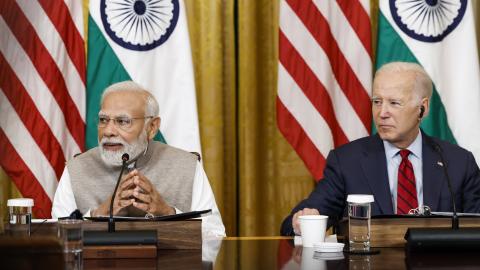By most measures, the recent state visit by Prime Minister Narendra Modi marked a high point in the U.S.-India relationship. President Joe Biden called the partnership “among the most consequential in the world” and “stronger, closer, and more dynamic than any time in history.” And it is getting stronger: The United States became India’s largest trading partner this past year, and the visit yielded a bevy of new agreements, including one to jointly manufacture fighter jet engines.
But doubts about India linger in the United States. A group of progressive House Democrats boycotted Modi’s address to a joint session of Congress. “We must never sacrifice human rights at the altar of political expediency,” they argued in a statement. Others fear that India cannot live up to the expectations of being a “consequential” partner because it lags too far behind China and—as evinced by its relatively muted response to Russia’s invasion of Ukraine—does not see autocracy as a global threat. Eminent India hand Ashley Tellis writes, for example, that “Washington’s current expectations of India are misplaced.”
Their concerns should be taken seriously, but if carried too far they could uproot a still-blossoming relationship that has not yet borne its full fruit. The views of the ruling right-wing Bharatiya Janata Party (BJP) on human rights and dignity—particularly on freedom of speech—-sometimes clash with those of Westerners, and the geopolitical situation can look very different from New Delhi than it does from New York. But the shared interests and values between the world’s two largest democracies can offer a sturdy foundation for the relationship.
In fairness to the India skeptics, American history shows that India has disappointed before. When American and French forces celebrated their victory at Yorktown in the Revolutionary War, they toasted “the great and heroic Hyder Ali,” their south Indian comrade-in-arms who sought to “reduce the power of Britain in the East Indies.” India proved too disunited to fend off Britain though, and Lord Cornwallis redeemed his surrender at Yorktown by defeating Hyder Ali’s son. Much later, after India finally gained independence in 1947, an American diplomat called Prime Minister Jawaharlal Nehru “outstandingly the most vital and influential person for the accomplishment of U.S. objectives in Asia.” That was before India’s “nonalignment” foreign policy tilted toward the Soviet Union.
For the Hindu right, this was one of Nehru’s many mistakes. Three decades ago, journalist Girilal Jain lamented that “a more confident Hindu psyche would never have spurned the US offer of cooperation” that President Dwight Eisenhower extended, and he argued that China’s victory in the 1962 Sino-Indian War “knocked down two myths” at the center of Nehru’s nonalignment: that communist states were not aggressive and that peaceful coexistence would secure India’s future without a costly military buildup. The BJP and its predecessors have often been warier of China and warmer toward America than have their Nehruvian opponents.
India and the United States share important interests today. Preventing any one country from dominating Asia is vital for America’s well-being. Similarly, according to Indian Minister of External Affairs Subrahmanyam Jaishankar, “Creating a stable balance in Asia is India’s foremost priority.” Jaishankar has condemned Beijing’s exploitative trade policies and its flagship China-Pakistan Economic Corridor infrastructure project, which he says “openly violates India’s sovereignty.” India recognizes that Southeast Asia is crucial to the overall balance in Asia, as its cruise missile sales to the Philippines and recent endorsement of an international ruling dismissing Chinese claims in the South China Sea reveal, and it is working to keep the region out from under Beijing’s thumb.
India’s pursuit of balance in Asia largely explains its treatment of Russia. New Delhi had long relied on Russian power to counter China, and from its perspective, the Taliban’s victory in Afghanistan and Moscow’s “no limits” partnership with Beijing are twinned catastrophes. Indian foreign policy experts quietly concede that the Russia partnership is part of India’s past, not its future, but since their military will still use legacy Russian equipment for years to come, they are not eager to alienate Moscow.
Tellis argues that “New Delhi will never involve itself in any U.S. confrontation with Beijing that does not directly threaten its own security” because of China’s greater power and the threat it poses along their disputed border. But Indian forces already confront their Chinese counterparts daily, and India sits astride the major trade routes that connect China to Middle Eastern energy and European markets. China will devote more resources to control those routes, so Americans can either let India be encircled by China’s “string of pearls” or help India stand firm and complicate Beijing’s calculations.
These matters are of secondary importance to some Americans. As they see it, the Indian government’s heavy-handed treatment of critical journalists and intellectuals, the crackdowns on foreign-funded NGOs, and outbursts of ethnic and religious violence (more than 100 people have died in a conflict in Manipur that started in May) all point in an ominous direction. They fear that these events, many of which they interpret through an Indian elite that generally sympathizes with Nehru’s Congress Party, are destroying India’s democracy. To them, any assistance to India on this dark path is an act of malice.
They may scratch their heads when Modi tells the U.S. Congress that “democracy is one of our sacred and shared values” and that “India is the Mother of Democracy,” but the Hindu right nods along. The BJP’s forerunner opposed the “national emergency” that Nehru’s daughter Indira Gandhi used to rule by decree after losing her seat in parliament. And as former BJP National General Secretary Ram Madhav pointed out in The Hindutva Paradigm, his book about the Hindu right’s ideology, Hinduism has a bottom-up tradition of arriving at truth through discussion and debate that naturally complements democracy.
Balancing majoritarian rule with minority rights is a challenge for every democracy, and India’s choices will not be America’s, regardless of who governs it. The Hindu right believes that India still needs to shed the legacy of domination by waves of Muslim invaders—this is the “thousand years of foreign rule in one form or another” that Modi mentioned in his address to Congress—and revitalize itself.
National self-confidence movements can take very dark turns, but they also can foster the solidarity needed for great accomplishments. Mohan Bhagwat, the head of Rashtriya Swayamsevak Sangh, the most influential organization on the Hindu right, seems aware of this dilemma and is quietly steering the movement away from its worst excesses and in a more positive direction. Even some of Modi’s Indian critics have acknowledged to me that he has forced Indian politicians to focus on delivering economic growth and development rather than on the special-interest horse trading that has hitherto marked Indian politics.
Nationalist projects like India’s often go awry, but American critics could create a self-fulfilling prophecy. For example, if India fears that the U.S. will turn hostile over human rights or cut off its access to American arms, it is more likely to maintain its defense partnership with Russia and even keep its options open with China. And a country that in 2019 processed 610 million ballots nearly as quickly as California tabulated its much smaller 2020 totals will justifiably bristle at criticism about its democracy.
There are not many countries signing up to confront China. India is large, growing, friendly, and democratic. What more should Americans demand?

















